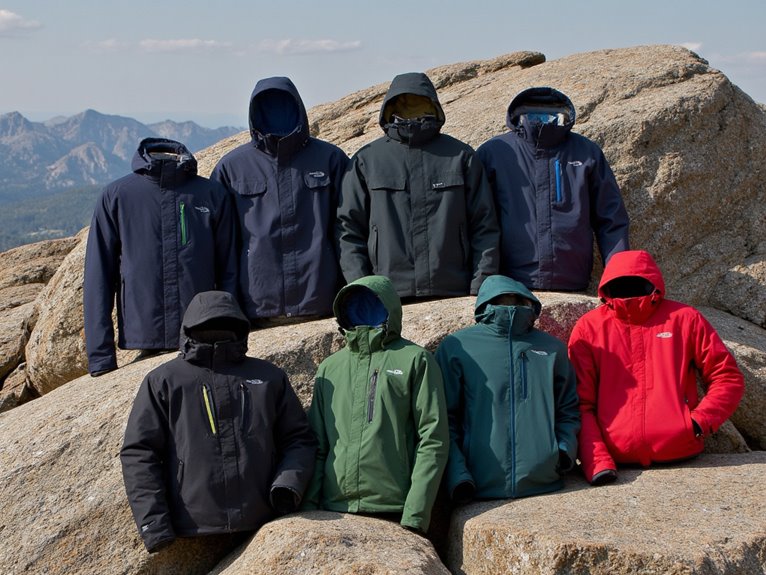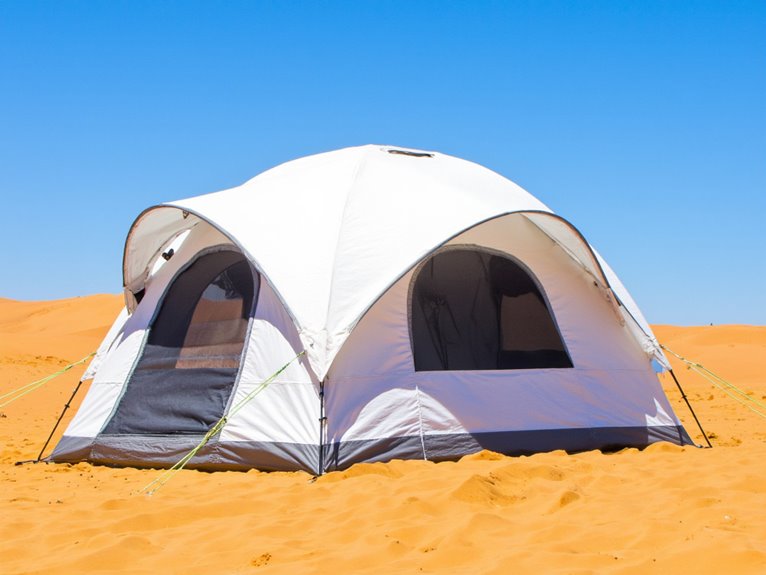Sleeping Bag Hoods, Draft Collars & Baffles: What They Do
Your sleeping bag’s hood, draft collar, and baffles form a critical thermal management system that prevents up to 65% of heat loss. The hood retains warmth from your head and neck, where you lose roughly 40% of body heat. Draft collars create an insulated seal around your shoulders to prevent warm air escape during movement. Baffles maintain even insulation distribution and prevent cold spots by stopping down migration. Understanding how these features work together will help you select the ideal configuration for your specific camping conditions.
We are supported by our audience. When you purchase through links on our site, we may earn an affiliate commission, at no extra cost for you. Learn more. Last update on 18th December 2025 / Images from Amazon Product Advertising API.
Notable Insights
- Sleeping bag hoods prevent up to 40% of heat loss from the head and neck using adjustable cinch cords and high-loft insulation materials.
- Draft collars create an insulated seal around neck and shoulders, preventing warm air from escaping during movement and sleep position changes.
- Draft tubes run along zippers to block cold air entry while maintaining zipper functionality through insulated barriers and continuous seals.
- Baffles ensure even insulation distribution by creating fabric chambers that prevent down migration and eliminate cold spots throughout the sleeping bag.
- These features are essential for temperatures below 20°F but may cause overheating in warm weather camping conditions.
Understanding Heat Loss and Why These Features Matter
When you’re trying to stay warm in your sleeping bag, understanding how your body loses heat becomes essential for choosing the right gear. Your body sheds heat through four primary mechanisms: conduction to cold surfaces, convection from air movement, radiation into the environment, and evaporation from moisture.
You’ll lose approximately 25% of your heat through respiration and perspiration alone.
Thermal efficiency depends on minimizing these heat loss pathways. Conduction occurs when you contact cold ground or tent floors. Convection happens when cold air circulates past your body or infiltrates your bag. Radiation disperses heat directly into surrounding space.
Quality sleeping bag features directly combat these mechanisms to maximize insulation effectiveness. The shell fabric and construction methods impact heat retention, with materials like polyester and nylon featuring ripstop weaves for added durability and thermal performance. Without proper design elements, even premium fill materials can’t maintain ideal warmth retention.
Sleeping Bag Hoods: Your First Line of Defense Against Cold
Your head and neck represent the most critical heat loss zones in any sleeping system, making a well-designed hood your primary defense against overnight temperature drops. These areas can lose up to 40% of your body heat when exposed to cold air. Proper hood insulation creates a thermal barrier that maintains head warmth throughout the night.
A well-designed hood serves as your primary defense against losing up to 40% of body heat through your head and neck.
Modern sleeping bag hoods incorporate several key design elements:
- Adjustable cinch cords – Allow precise fit customization to seal out cold air drafts
- High-loft insulation materials – Down or synthetic fills provide maximum thermal retention
- Waterproof treatments – Prevent moisture infiltration that compromises insulating properties
- Breathable fabric construction – Manages humidity while maintaining warmth retention
Quality hoods directly impact your sleeping bag’s temperature rating by preventing convective heat loss through the head opening. When selecting a sleeping bag, consider that temperature ratings typically require adding 25-30°F for true comfort levels, making hood effectiveness even more crucial for maintaining warmth.
Draft Collars: Sealing Warmth at the Neck and Shoulders
A draft collar functions as an insulated tube positioned between your sleeping bag’s hood and main body, creating a seal around your neck and shoulders to prevent warm air from escaping during sleep.
This feature becomes essential when you’re moving around at night, as it eliminates the bellows effect that would otherwise pump heated air out of your bag with every shift in position.
Premium cold-weather sleeping bags rely on draft collars filled with high-loft down insulation to extend their effective temperature ratings and maintain consistent warmth in alpine conditions.
Draft collars work in conjunction with enhanced zippers that feature extra webbing to facilitate smooth operation while maximizing heat retention throughout the night.
How Draft Collars Work
Draft collars function as specialized insulation barriers that seal the critical junction between your sleeping bag’s hood and main body compartment. They wrap around your neck and shoulders, creating an insulated tube that prevents warm air from escaping through the head opening.
When you move during sleep, the collar stops the bellows effect—where body movement pushes heated air out and draws cold air in.
Draft collar effectiveness depends on proper positioning and fill quality. The collar acts like a thermal dam, maintaining your bag’s internal temperature by eliminating air gaps around your upper torso.
Key mechanisms include:
- Insulated tube design wraps completely around neck area
- Thermal barrier blocks heat loss through shoulder gaps
- Anti-bellows protection prevents air exchange during movement
- Insulation types include down fill or synthetic alternatives for maximum warmth retention
Premium Cold Weather Benefits
When temperatures drop below 20°F, draft collars transform from helpful features into performance necessities that can mean the difference between comfortable sleep and a miserable night outdoors. These premium features become essential for maintaining your bag’s rated performance when you’re pushing its thermal limits.
You’ll find draft collars most beneficial if you’re a restless sleeper or side sleeper who moves frequently during the night. The internal elastic cord adjusts to create a custom seal around your neck, preventing heat loss when you shift positions and potentially break the face-hole seal.
Different insulation types work with draft collars to trap warm air effectively. Down insulation compresses less when the collar tightens, while synthetic fills maintain loft even under pressure.
Both materials benefit from the collar’s ability to prevent convective heat loss at your shoulders and neck.
Draft Tubes: Preventing Cold Air Entry Along Zippers
Draft tubes run along your sleeping bag’s zipper to block cold air from entering through the zipper teeth and seams.
You’ll find these insulated tubes positioned directly behind the zipper, where they create a thermal barrier using down fill, synthetic insulation, or fleece materials that match your bag’s primary insulation type.
The tube’s construction involves sewing a fabric channel filled with insulating material to the interior zipper tape, forming a continuous seal that prevents convective heat loss along the entire zipper length.
Draft Tube Construction
While many sleeping bag features work to retain warmth, the zipper remains one of the most vulnerable areas for heat loss in any sleeping system. Draft tube construction addresses this thermal weak point through strategic design and material placement.
The construction process requires specific technical considerations. Draft tube materials must match the sleeping bag’s primary insulation to maintain consistent thermal performance.
Draft tube designs vary, but effective construction follows established protocols:
- Insulation selection – Choose materials matching the bag’s fill type and loft rating
- Tube formation – Shape tubes to create complete zipper coverage without compression
- Secure attachment – Bond tubes to shell fabric using reinforced stitching patterns
- Integration testing – Verify thermal continuity across all connection points
Proper construction eliminates thermal bridging while maintaining zipper functionality and durability standards.
Cold Air Prevention
Although sleeping bags provide excellent insulation, the zipper’s metal or plastic teeth create an uninsulated pathway that allows cold air to penetrate the bag’s thermal barrier.
Draft tubes solve this problem by creating an insulated barrier along the zipper’s entire length.
These tubes contain the same insulation as your bag’s main compartments. Down-filled draft tubes compress less and provide superior warmth-to-weight ratios, while synthetic alternatives maintain insulation properties when wet.
The tube runs behind the zipper, creating a seamless seal that prevents thermal bridging.
Effective draft prevention techniques include overlapping tube edges and secure attachment points every 6-8 inches.
This insulation types comparison shows down performs better in dry conditions, but synthetic materials excel in humid environments where moisture management matters most.
Insulation Material Types
Material composition determines how effectively draft tubes prevent thermal bridging along your sleeping bag’s zipper. Different insulation types offer varying levels of material performance based on their construction and thermal properties.
Draft tubes use four primary insulation materials:
- Down insulation – Provides exceptional warmth-to-weight ratio with 650-900 fill power ratings.
- Synthetic polyester – Maintains insulation properties when wet, typically 40-80% heavier than down.
- Hybrid combinations – Blends down and synthetic materials for balanced performance.
- Micro-fiber fills – Ultra-fine synthetic fibers mimicking down’s loft characteristics.
Synthetic materials excel in humid conditions but add weight. Down offers superior compressibility at 2-3 times less packed volume than synthetics.
Material performance directly correlates with fiber diameter and loft retention. Manufacturers select materials matching the bag’s primary insulation to guarantee consistent thermal properties throughout the zipper zone.
Baffles: Maintaining Even Insulation Distribution
Since sleeping bags can develop cold spots when insulation shifts during use, baffles serve as the primary defense against uneven heat distribution throughout the bag’s interior.
These fabric chambers prevent down migration to one end of the bag, maintaining consistent warmth across all sections. Vertical baffles demonstrate superior baffle efficiency by keeping insulation closer to your body, while their design allows for better lofting of fill material.
Vertical baffles maximize thermal efficiency by preventing insulation migration while maintaining optimal loft and keeping warmth close to your body.
Different baffle orientations affect insulation uniformity throughout the bag. Continuous baffles let you manually redistribute down fill when needed.
Boxwall designs feature sidewalls that prevent stitching from penetrating both shells, reducing thermal bridging.
V baffles offer the highest thermal performance with inclined sidewalls that form interlocking chambers, though they increase weight and manufacturing complexity.
Comparing All Four Features: Location, Purpose, and Best Uses
Four distinct features work together to maximize your sleeping bag’s thermal efficiency: hoods, draft collars, baffles, and draft tubes. Understanding their sleeping bag comparison helps optimize feature functionality for different conditions.
Each component targets specific heat loss mechanisms:
- Hoods – Cover head and neck areas, preventing up to 40% of body heat loss through adjustable closures.
- Draft collars – Seal chest and shoulder regions, eliminating the bellows effect during movement.
- Baffles – Maintain even insulation distribution throughout the bag’s interior compartments.
- Draft tubes – Block cold air infiltration along zipper lines with insulated fabric strips.
Draft collars excel in winter conditions where movement creates air exchange.
Hoods prove essential below 32°F when head protection becomes critical.
Baffles function year-round, ensuring consistent warmth distribution regardless of temperature.
While stitched-through baffles offer budget-friendly construction, they create thermal bridges that can compromise warmth in extreme conditions.
Choosing the Right Combination for Your Camping Conditions
When selecting the ideal feature combination, your camping environment dictates which thermal components you’ll actually need versus those that add unnecessary weight and bulk.
Cold weather expeditions require draft collars and hood cinches for maximum heat retention. Warm-weather camping makes these features unnecessary and potentially uncomfortable.
Match your sleeping bag’s thermal features to your camping climate—excess insulation becomes dead weight in warm conditions.
Your insulation choices depend heavily on moisture exposure.
Synthetic fill maintains warmth when wet, making it superior for damp environments. Down insulation provides better warmth-to-weight ratios in dry conditions but fails when saturated.
Temperature ratings should fall 10-15 degrees below expected nighttime lows.
Backpackers prioritize lightweight baffle designs over maximum comfort features. Car campers can afford heavier bags with thorough thermal systems.
Budget considerations often eliminate premium features like adjustable draft collars and advanced baffle configurations.
High-quality down bags with proper baffle design prevent insulation migration and can maintain their thermal efficiency for decades with appropriate care.





